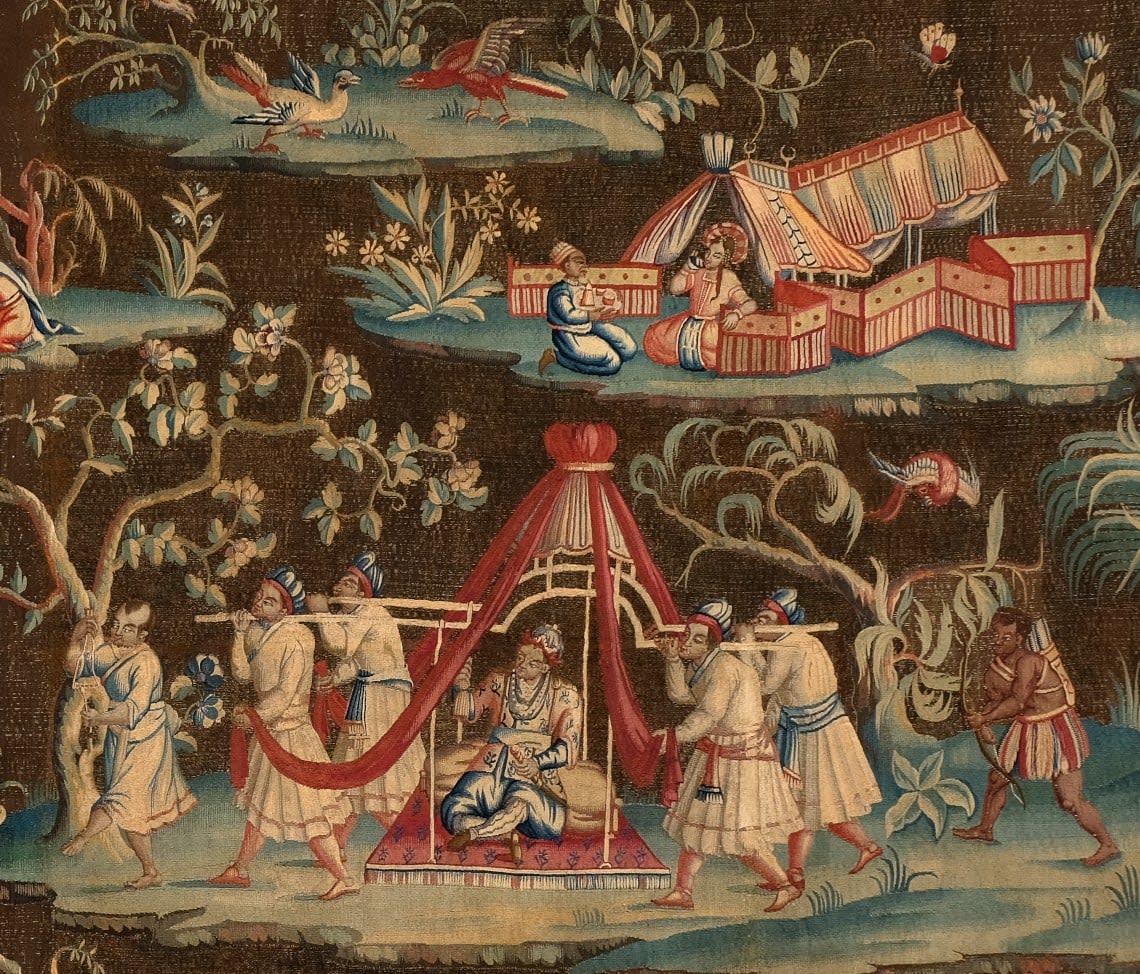Soho Tapestry ‘After the Indian Manner’
ENGLAND – LONDON, SOHO, late 17th Century
267 x 318 cm
Further images
Provenance
Ickwell Bury Manor. Sold to Cameron in the Knight, Frank & Rutley Sale on the 11th November 1927, lot no. 4, for 750 guineas. Acquired from Maurice Aveline, antiquarian in Paris on 21st November 1956.Literature
Illustrated in H.C. Marillier’s manuscript ‘Subject Catalogue of Tapestries’ in the V&A.Showing a series of scenes set on a number of small exotic islands, which are scattered, as if floating, over the surface of the dark ground. The tableaus include depictions of a court lady and her servant; a hunting scene; and a gentleman being carried on a palanquin (a covered sedan chair carried on four poles). Each individual scene takes place on a different island, with brightly coloured exotic chinoiserie flowers, trees, birds and animals, including a monkey and a parrot. The tapestry’s border presents pictures of exotic porcelain – small teapots, cups, and vases – with blue dragons and twisting birds at each corner. The motifs on the tapestry are smaller in scale at the top, becoming larger lower down, which creates a distinct foreground to the tapestry. This arrangement is common to all tapestries made ‘after the Indian Manner’. This expression was first used in a bill from John Vanderbank, Yeoman Arrasworker to the Great Wardrobe, dated August 1690, which was for ‘4 Peeces of fine Tapestry Hangings designed and workt after the Indian Manner’ for Queen Mary’s apartments at Kensington Palace.
Michael Mazarind: Michael Mazarind was a 17th Century weaver about whom very little is known. He was a rival of the more well-known London tapestry weaver John Vanderbank. He is believed to have had a workshop on the south side of Portugal Street (now Piccadilly), London between 1696 and 1702. The only surviving tapestry with the workshop mark for Mazarind, which Standen references, had a temporary export bar placed upon it in October 2016. ‘The Arts Council’s Expert’s Adviser Submission for the English Tapestry in the Japan/Indian Manner (Case 9, 2016-17)’ suggests that the style and content of this tapestry are particular to Mazarind’s workshop, which is ‘especially obvious in the curious tent-like buildings, some of the figures and their garments, and the type of palm tree with long thin leaves.’ The Submission continues, stating that: ‘The distinctive design characteristics of the current tapestry confirm the origin in Mazarind’s workshop of three other pieces, which also had the same border of blue and white porcelain. Two were sold from Ickwell Bury in 1927 (illustrated in H C Marillier’s manuscript Subject Catalogue of Tapestries in the V&A). Of those one is now in the David Collection, Copenhagen; the whereabouts of the other is unknown. None of these other three pieces has Mazarind’s signature, however.’ (The Arts Council’s Expert’s Adviser Submission for the English Tapestry in the Japan/Indian Manner (Case 9, 2016-17); click here to download the PDF, p.3). Our tapestry is the one for which ‘the whereabouts … is unknown’.
Henry Currie Marillier (1865-1951) was an expert on tapestries and the managing director of Morris and Co. from 1905-1940. He was a prolific researcher and spent many years compiling a subject-index and illustrated catalogue of European tapestries, which is now in the Victoria and Albert Museum. This catalogue includes an image of our tapestry, which identifies it as Lot Number 4 in the Knight Frank & Rutley sale on 11th November 1927 and a note which states: ‘Soho. / Ickwell Bury. Biggleswade (Col John Hawey DSP) / Also another. / Nos 4 and 5 / Knight Frank & / Rutley sale / Nov 11. 1927. / (F. Partridge 1000 gs. / The other, Cameron 750 gs) / The Partridge piece / has passed to Lord / Fairhaven. Anglesey / Abbey, Cambs.’ .
The tapestry in the Davids Samling, Copenhagen, is recorded as being woven from wool and silk and is dated circa 1730. It is larger than our tapestry, measuring 244cm in height by 521cm in width (Inv. no. 18/1978).
In her article ‘English Tapestries “After the Indian Manner”’ (‘Metropolitan Museum Journal 15’, 1980), Edith A. Standen states that: ‘It has long been recognised that the general scheme of these tapestries is taken from Chinese lacquered screens, which were imported into England in large numbers during the second half of the seventeenth century’ (ibid, p.127). Standen comments that the motifs in the ‘Indian Manner’ tapestries reappear and that ‘[a]rbitrary titles have been given to certain combinations of motifs.’ She notes that ‘some forty motifs can be counted on the dark-ground “Indian manner” tapestries, not including islands with plants only’ and that ‘they are usually arranged… in fairly consistent relationships’ (ibid, p.123, pp.126-7). Our tapestry bears similar motifs on its right hand side to the motifs which appear in a tapestry in Sir Alfred Beit’s collection, which has been called ‘The Tea Party in a Garden Tent’ . At the upper right hand side of both tapestries there is a man sitting at the opening of a long tent and smoking a pipe; below which there is a seated man being carried by four servants; and below that are two men attacking a four legged exotic beast. The same motifs appear on the right hand side of both tapestries.
‘The Tea Party’, Wool and silk tapestry. England, late 17th-early 18th Century. Russborough, Ireland, Sir Alfred Beit Collection
Standen notes that: ‘[a]t least six types of borders are known’ (ibid, p.127) and refers to a tapestry signed ‘M. Mazarind’, which has ‘a distinctive border of small teapots, cups, and vases, with red-tongued blue dragons and twisting birds at the corners, all very Chinese’ (ibid, p.126). A very similar border appears on our tapestry and can also be found on the border surrounding the tapestry illustrated in Standen’s article ‘English Tapestries “After the Indian Manner”’ on page 125, figure 7, which is recorded as being late 17th-early 18th Century and is entitled ‘The Tent’.










